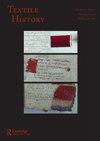Claire Wilcox, Patch Work — A Life Amongst Clothes
IF 0.1
2区 社会学
0 HUMANITIES, MULTIDISCIPLINARY
引用次数: 0
Abstract
ferent Atlantic locale and a textile medium that is understood broadly through written sources. The first chapter’s exploration of the English writer Virginia Ferrar’s seventeenth-century texts on silkworm production in the colony of Virginia includes exciting archival discoveries and an astute analysis of Ferrar’s published writing, marginalia and drawings. It deftly demonstrates how an English woman used her gendered authoritative understanding of textiles to contribute to colonial knowledge production. The notion of textiles as ‘women’s work’ and the ways in which that facilitated female participation in colonial projects is also explored in later chapters on homespun in colonial New England, the fashions of enslaved and free Creole women in the Caribbean and silk embroidered samplers and globes in the early American Republic. Skeehan shows that, by expanding what counts as a text, we may likewise expand who counts as an author. The intersection of textiles with economic and political systems that sustained, and were sustained by, colonial and racial ideologies is explored throughout the book, including chapters focused on the global cotton trade and Latin American woven textiles. In situating textiles alongside literary texts, Skeehan aims to ‘complicate what we mean by the practice of letters, and ... rethink which authors and what texts constitute the corpus of early American literature’ (p. 3). It is a laudable and methodologically interesting project. Ultimately, however, I think it is one that is mainly intended to contribute to literary history. While the book offers nuanced analysis of a wide range of specific written texts, from business letters to novels, textiles are mostly simply described, usually as a category or type. Discussion of actual examples of textiles are few, and they are afforded little contextualisation or substantive interpretation. Citations to scholarship on specific types of textiles are equally thin. Asserting that textiles are ‘material texts’, though apparently intended to elevate the humble textile, has the effect of subsuming visual and material expression entirely to the logic and hermeneutics of the text. Though Fabric of Empire clearly wants to believe that ‘the textile can speak’ (to invoke Gayatri Spivak), the book never really speaks its language. The overriding claim that textiles, too, are bearers of meaning is unlikely to be revelatory to readers of this journal. As such, despite Skeehan’s aim to challenge dominant narratives and decentre disciplinary norms, the book curiously ends up reinforcing the disciplinary boundaries it seeks to dissolve.克莱尔·威尔科克斯,《补丁工作——与衣服为伍的生活》
不同的大西洋地区和一种通过书面资料广泛理解的纺织媒介。第一章探索了英国作家弗吉尼亚·费拉(Virginia Ferrar) 17世纪关于弗吉尼亚殖民地蚕生产的文本,包括令人兴奋的档案发现和对费拉出版的作品、旁注和图纸的敏锐分析。它巧妙地展示了一位英国女性如何利用她对纺织品的性别权威理解为殖民知识生产做出贡献。纺织品作为“妇女的工作”的概念,以及促进女性参与殖民项目的方式,也在后面的章节中探讨了殖民地新英格兰的土布,加勒比地区被奴役和自由的克里奥尔妇女的时尚,以及早期美国共和国的丝绸刺绣样品和地球仪。斯基汉指出,通过扩展文本的定义,我们同样可以扩展作者的定义。纺织品与经济和政治制度的交集,维持和维持,殖民和种族意识形态,贯穿全书,包括章节侧重于全球棉花贸易和拉丁美洲编织纺织品。通过将纺织品与文学文本放在一起,Skeehan的目的是“使我们通过字母实践的意思复杂化,并且……重新思考哪些作者和哪些文本构成了早期美国文学的语料库”(第3页)。这是一个值得称赞和方法论上有趣的项目。但归根结底,我认为这本书的主要目的是为文学史做出贡献。虽然这本书对从商业信函到小说等广泛的具体书面文本进行了细致入微的分析,但纺织品大多被简单地描述为一种类别或类型。对纺织品的实际例子的讨论很少,而且很少提供上下文化或实质性解释。关于特定类型纺织品的学术引文也同样少之又少。断言纺织品是“物质文本”,虽然显然是为了提升卑微的纺织品,但却有将视觉和物质表达完全纳入文本的逻辑和解释学的效果。尽管《帝国的织物》显然想要相信“纺织品会说话”(引用加亚特里·斯皮瓦克的话),但这本书从未真正说出它的语言。纺织品也是意义的载体这一最重要的主张,不太可能对本杂志的读者产生启示。因此,尽管斯基汉的目标是挑战主流叙事和分散学科规范,但奇怪的是,这本书最终却强化了它试图消解的学科界限。
本文章由计算机程序翻译,如有差异,请以英文原文为准。
求助全文
约1分钟内获得全文
求助全文
来源期刊

TEXTILE HISTORY
HUMANITIES, MULTIDISCIPLINARY-
CiteScore
1.00
自引率
0.00%
发文量
0
期刊介绍:
Textile History is an internationally recognised, peer reviewed journal and one of the leading publications in its field. It is viewed as an important outlet for current research. Published in the spring and autumn of each year, its remit has always been to facilitate the publication of high-quality research and discussion in all aspects of scholarship arising from the history of textiles and dress. Since its foundation the scope of the journal has been substantially expanded to include articles dealing with aspects of the cultural and social history of apparel and textiles, as well as issues arising from the exhibition, preservation and interpretation of historic textiles or clothing.
 求助内容:
求助内容: 应助结果提醒方式:
应助结果提醒方式:


